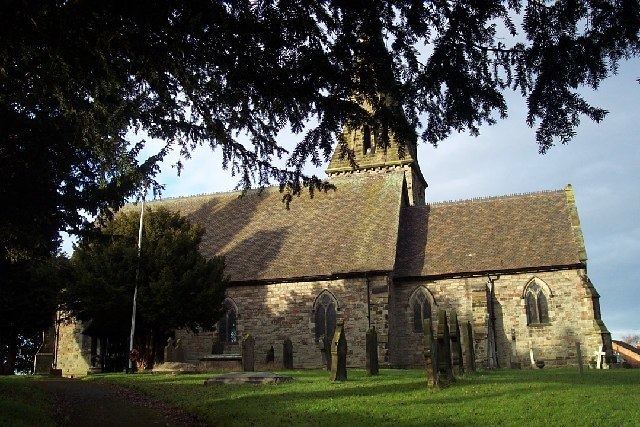Population 1,917 (2011) Post town STAFFORD Local time Monday 12:55 AM | Sovereign state United Kingdom Postcode district ST18 Dialling code 01889 | |
 | ||
Weather 5°C, Wind NW at 13 km/h, 94% Humidity | ||
Hixon is a village and a civil parish in the English county of Staffordshire.
grid reference SK003259
Contents
- Map of Hixon UK
- Location
- Etymology
- The Domesday Book
- RAF Hixon
- The Parish Church of Saint Peter
- Hixon Halt and the railway
- Hixon rail crash
- Bus services
- References
Map of Hixon, UK
Location
The village is 7.8 miles (12.6 km) east of the town of Stafford, and 8.6 miles (13.8 km) south west of Uttoxeter. The nearest railway station is at Stafford. The nearest main roads are the A518 which skirts 1.3 miles (2.1 km) north of the village, and the A51 which runs to the west.
Etymology
The genesis of the village name is said to be of Scandinavian origin. The first part, Hus is thought to be the Viking word for house. The last part Dun is an old English word for Hill, so giving the origins as The House on the Hill. Another school of thought originates the name from a person known as Hyht with the following es indicating it in the possession and can be interpreted as Hyht's hill. Over the years the village has been recorded under the names Huchtesdona in 1130, Huhtesdon and Huytesdon.
The Domesday Book
Hixon is listed in the Domesday Book of 1086. In the survey the village has the name Hustedone. and was described as being very small with five households. The village assets included two ploughs, a meadow and 3 acres. The head of the manor was Haywood. In 1066 the lord of the manor was the Bishop of Chester. In 1086 the lord of the manor was Nigel of Stafford and the Bishop of Chester was now the tenant-in-chief. The survey also states that the value of the parish was 10s 9d.
RAF Hixon
During the Second World War, Hixon was the location of a Royal Air Force Station built for RAF Bomber Command. The station opened in 1942 on a site located 0.9 miles (1.4 km) north west of the village and had the station identification code of HX. Three intersecting concrete runways were built on the station, which were surfaced with tarmac for use by Class-A bombers. The station building and technical site were located on the south east of the station and included accommodation and communal facilities for 2938 RAF personnel. There were also four T2 type hangars and one MAP B1 aircraft hangar. Overseeing the station was a 1941 pattern control tower which still survives and is currently being used as industrial offices. During the war bomber aircraft that used the base included Vickers Wellingtons, Avro Lancasters and Bristol Blenheims. Other types that operated from the station included Curtiss P40 Tomahawks, Miles M.9 Masters, Miles M.25 Martinets and Hawker Hurricanes which were mainly used for training.
The Parish Church of Saint Peter
The parish church of Saint Peter was designed and built by the English Gothic revival architect George Gilbert Scott. The church, which is a Grade II listed building, is built in the early English Gothic style.
Hixon Halt and the railway
The village was connected to the rail network when the North Staffordshire Railway was routed through the area along the Trent Valley. The station was called Hixon Halt and it was opened in 1847 two years after the railway line had first been opened in 1845. Hixon Halt was located half a mile south of the village but was closed for passengers in 1947.
Hixon rail crash
On 6 January 1968 an 120-ton transformer was being moved from the English Electric factory at Stafford to storage on the disused airfield at Hixon. The road train grounded on the level crossing in New Road (aka Station Road), Hixon. An express train from Manchester London Road to Euston ran into the transformer. Eleven people were killed and twenty seven seriously injured. Following this accident the requirements for telephones at automatic crossings were increased greatly and their position and signage improved. The level crossing was eventually replaced by a bridge in 2002.
Bus services
D&G Bus run two local services to Stafford, Uttoxeter and Rugeley
